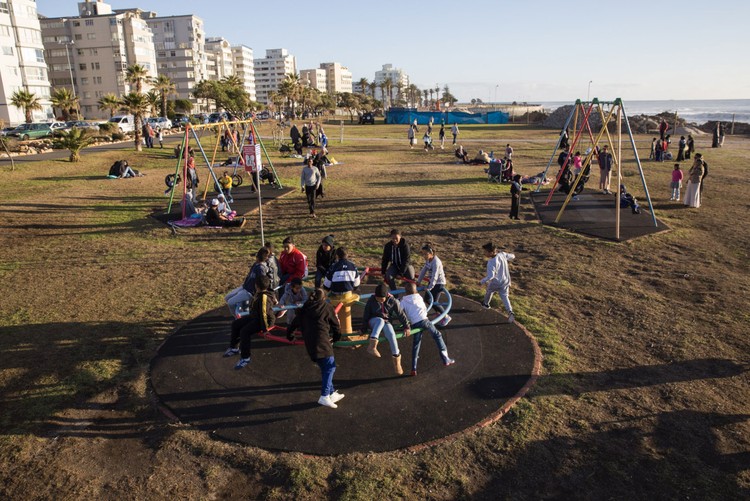Parks for the people: everyone needs green spaces
Urban South Africans use what little green space is available to them very creatively, and deserve more support
Green spaces in urban areas can be used for children to play, for spiritual rituals, exercise, social gatherings, and to grow food and medicinal plants. Archive photo of Seapoint: Ashraf Hendricks
Religious gatherings often take place on what little green space is available in cities. These spaces must be preserved and protected, say the authors.
All city dwellers need green spaces. In South Africa, parks are mostly in rich suburbs, but people in other areas have found creative ways to use what little “green infrastructure” is available to them – often with no official help.
Green infrastructure includes public parks, street trees, green roofs, nature reserves, urban agriculture, and greenways.
A recent study by Zander Venter and colleagues found that parks in South Africa occur mainly in neighbourhoods with an average of 82% higher income than areas without parks, and white-dominated neighbourhoods have 12% higher tree cover than other areas. The researchers used the Open Street Maps platform to analyse available park areas in all cities across the country. The results led them to coin the phrase “green apartheid”.
The World Health Organisation recommends that a minimum of 9m2 of green space be available per person. For many people, especially the urban poor, this standard is not met.
But even where there are no parks, research by the Integrated Green Infrastructure Planning (GRIP) group (a joint project of Aarhus University and the University of Pretoria funded by the Danish International Development Agency) shows that people in South Africa make use of green infrastructure in uniquely local ways.
In between the dense, rapidly urbanising neighbourhoods, South African cities still contain many semi-natural tracts of land. These were included in spatial plans as buffers between racially segregated neighbourhoods under apartheid spatial planning.
Municipal-owned green spaces are being used for religious gatherings, collection of medicinal plants, urban food gardens and local mini-parks. But there is no legislation to help communities manage destructive practices or reward useful interventions – a shortcoming that gives city officials involved in green space management considerable frustration.
As a result, illegal dumping, vandalism and other criminal activities degrade ecological integrity and create concerns for the larger community.
Good quality, safe green spaces are essential for health. People tend to be more active when they spend time in nature, and research has shown that regular access to quality green space also has far deeper impacts on well-being. A large-scale epidemiological study in Denmark tracked access to nature for a million people from birth to ten years old and showed that being in green spaces during childhood is associated with lower risks of many psychiatric disorders later in life. This association remained even after adjusting for other factors such as genetic predisposition and socioeconomic standing.
Elsewhere, scientists have measured positive results on heart rate, blood pressure, and cognitive function after as little as five minutes spent in a natural setting. In America, quality parks have been correlated with a reduction in gang activity, though it is not yet clear if all this can be directly translated to a South African context.
Beyond the health and community benefits of access to nature, scientists are looking at nature-based solutions to climate change, such as the use of green infrastructure to reduce the impact of flooding and provide refuges from the heat.
The current inequalities in green space provision have roots in apartheid spatial planning. But in the early 2000s, South African cities had very low urban densities of 15 to 22 dwelling units per hectare. (For purposes of comparison, 30 dwelling units per hectare is considered medium density and 70 is considered high density. Informal settlements have up to 160 dwellings per hectare.)
At the time, policy had two primary objectives: tackling the legacy of apartheid by creating mixed-income neighbourhoods and developing areas that had been used to separate races, and densifying our cities. The emphasis was also on providing roads, houses and electricity to address backlogs.
Twenty years on, the net result is that we have sacrificed quality urban green spaces at the altar of densification and unplanned urban expansion. This has alarming implications for people in poor areas.
If we want to build sustainable cities, green infrastructure must be planned and developed with the communities who will use it.
In South Africa, we use green infrastructure for children to play, for spiritual rituals, exercise, social connection and picnics, and to grow food and medicinal plants. These activities have multiple benefits for our well-being as a society and deserve encouragement and protection.
Views expressed are not necessarily those of GroundUp.
Support independent journalism
Donate using Payfast

Don't miss out on the latest news
We respect your privacy, and promise we won't spam you.
Next: Dunoon residents hope years of “tip-toeing over sewage” will end
Previous: We’re not alone: Cape Mental Health members share their experiences
© 2022 GroundUp. This article is licensed under a Creative Commons Attribution-NoDerivatives 4.0 International License.
You may republish this article, so long as you credit the authors and GroundUp, and do not change the text. Please include a link back to the original article.
We put an invisible pixel in the article so that we can count traffic to republishers. All analytics tools are solely on our servers. We do not give our logs to any third party. Logs are deleted after two weeks. We do not use any IP address identifying information except to count regional traffic. We are solely interested in counting hits, not tracking users. If you republish, please do not delete the invisible pixel.

